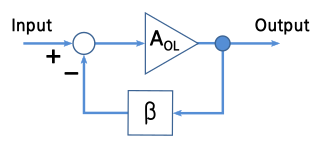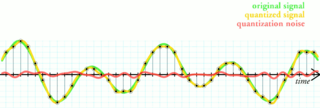Derivation
For a derivation of Friis' formula for the case of three cascaded amplifiers ( ) consider the image below.
) consider the image below. 
A source outputs a signal of power  and noise of power
and noise of power  . Therefore the SNR at the input of the receiver chain is
. Therefore the SNR at the input of the receiver chain is  . The signal of power
. The signal of power  gets amplified by all three amplifiers. Thus the signal power at the output of the third amplifier is
gets amplified by all three amplifiers. Thus the signal power at the output of the third amplifier is  . The noise power at the output of the amplifier chain consists of four parts:
. The noise power at the output of the amplifier chain consists of four parts:
- The amplified noise of the source (
 )
) - The output referred noise of the first amplifier
 amplified by the second and third amplifier (
amplified by the second and third amplifier ( )
) - The output referred noise of the second amplifier
 amplified by the third amplifier (
amplified by the third amplifier ( )
) - The output referred noise of the third amplifier

Therefore the total noise power at the output of the amplifier chain equals

and the SNR at the output of the amplifier chain equals
 .
.
The total noise factor may now be calculated as quotient of the input and output SNR:

Using the definitions of the noise factors of the amplifiers we get the final result:
 .
.
General derivation for a cascade of  amplifiers:
amplifiers:
The total noise figure is given as the relation of the signal-to-noise ratio at the cascade input  to the signal-to-noise ratio at the cascade output
to the signal-to-noise ratio at the cascade output  as
as
 .
.
The total input power of the  -th amplifier in the cascade (noise and signal) is
-th amplifier in the cascade (noise and signal) is  . It is amplified according to the amplifier's power gain
. It is amplified according to the amplifier's power gain  . Additionally, the amplifier adds noise with power
. Additionally, the amplifier adds noise with power  . Thus the output power of the
. Thus the output power of the  -th amplifier is
-th amplifier is  . For the entire cascade, one obtains the total output power
. For the entire cascade, one obtains the total output power

The output signal power thus rewrites as

whereas the output noise power can be written as

Substituting these results into the total noise figure leads to


Now, using  as the noise figure of the individual
as the noise figure of the individual  -th amplifier, one obtains
-th amplifier, one obtains



















































